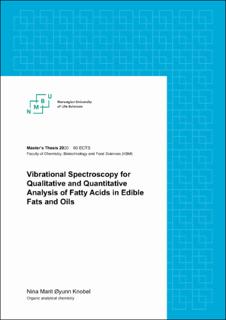| dc.contributor.advisor | Ekeberg, Dag | |
| dc.contributor.advisor | Afseth, Nils Kristian | |
| dc.contributor.author | Knobel, Nina Marit Øyunn | |
| dc.date.accessioned | 2021-01-06T09:22:42Z | |
| dc.date.available | 2021-01-06T09:22:42Z | |
| dc.date.issued | 2020 | |
| dc.identifier.uri | https://hdl.handle.net/11250/2721650 | |
| dc.description.abstract | Fats and oils are an important part of the diet for many organisms, and fatty acids (FA) are important structural components within organisms. Vibrational spectroscopy are rapid and non-destructive analytical tools, and in this study FTIR and Raman spectroscopy were applied for qualitative and quantitative analysis of fats and oils. Gas chromatography mass spectrometry (GC-MS) served as reference method. The goal was to develop calibration models that enable the prediction of FA content of single FAs, by creating a sample design with low correlation between the FAs. Multivariate methods were used to make the calibration models.
The first step concerned the classification of marine oils based on analysis with FTIR and Raman spectroscopy. Principal component analysis was used to differentiate oils based on their chemical composition. Next, the FA profiles of a set of reference oils was determined with GC-MS, by transforming the samples to fatty acid methyl esters prior to analysis. Based on these FA profiles a sample design with low correlation between the FAs was made, which gave rise to 80 calibration samples. The calibration set was analysed with FTIR and Raman spectroscopy. The obtained spectral data were used in combination with the reference analyses and partial least squares regression to establish calibration models. Lastly, the obtained calibration models were validated through analysis of independent oil samples.
Classification of marine oils showed that FTIR was a suitable method for differentiating various types of oils, while Raman spectroscopy could not be used for this purpose due to a strong fluorescence background. The calibration set was shown to have little correlation between the main FAs, and calibration models were achieved for the FAs C14:0, C16:0, C18:0, C18:1n-9, C18:2n-6, C18:3n-3, C20:5n-3 and C22:6n-3. All models had an R2 ≥ 0.93, some as high as 0.99. The models based on FTIR spectroscopy had lower RMSECV values than the models for Raman spectroscopy, and generally seemed to be more accurate and robust. Validation of the calibration models showed that both FTIR and Raman spectroscopy gave good predictions of FA content that clearly reflected the FA profiles in the analysed samples. In conclusion, both FTIR and Raman spectroscopy were shown to be promising methods for qualitative and quantitative FA determination in samples of edible oils. | en_US |
| dc.description.abstract | Fett og oljer er en viktig bestanddel av kostholdet til mange organismer, og både fett og fettsyrer har viktige funksjoner i organismer. Vibrasjonsspektroskopiske metoder brukes til rask og ikke-destruktive analyser, og i denne studien ble FTIR og Ramanspektroskopi anvendt til kvalitativ og kvantitativ analyse av oljer. Gasskromatografi massespektrometri (GC-MS) ble brukt som referansemetode. Målet med denne studien var å lage modeller for å bestemme innholdet av enkeltfettsyrer i fett og oljer. Dette skulle gjøres ved å lage et kalibreringssett med prøver basert på et prøvedesign med lav korrelasjon mellom de ulike fettsyrene. Analyse av kalibreringssettet i kombinasjon med multivariate metoder skulle gi kalibreringsmodeller for fettsyreprediksjon i fett og oljer.
Det første steget var å bruke FTIR og Ramanspektroskopi til klassifisering av marine oljer. Prinsipal komponent analyse ble anvendt for å skille oljene basert på kjemiske ulikheter. Neste steg var å bestemme fettsyreprofilene til et sett med referanseoljer, hvilket ble gjort ved å omestre oljene til fettsyremetylestere før analyse med GC-MS. På bakgrunn av disse fettsyreprofilene ble det laget et prøvedesign med lav korrelasjon mellom de ulike fettsyrene. Prøvedesignet ble brukt for å lage et kalibreringssett, som så ble analysert med FTIR og Ramanspektroskopi. PLS regresjon basert på spektrale data fra analysene og referansedata ble brukt for å lage modeller for fettsyreprediksjon. Det siste steget var å validere modellene som ble laget ved å analysere uavhengige oljeprøver.
Klassifiseringen av marine oljer viste at FTIR var en egnet metode for å skille mellom ulike typer olje. Raman spektroskopi var derimot lite egnet til analyse av marine oljer, da signalet i for stor grad ble påvirket av fluorescens. Kalibreringssettet hadde lav korrelasjon mellom hovedfettsyrene, og kalibreringsmodeller ble opprettet for fettsyrene C14:0, C16:0, C18:0, C18:1n-9, C18:2n-6, C18:3n-3, C20:5n-3 og C22:6n-3. Alle modellene hadde R2 ≥ 0.93, for noen modeller var R2 = 0.99. Modellene basert på FTIR spektroskopi hadde generelt lavere RMSECV verdier enn modellene for Raman spektroskopi, og de så også ut til å være mer nøyaktige og robuste. Validering av modellene viste at både FTIR og Raman spektroskopi ga gode verdier for fettsyreinnhold som gjenspeilet den faktiske fettsyreprofilen i de analyserte oljene. Det kan altså konkluderes med at både FTIR og Ramanspektroskopi er lovende metoder for kvalitative og kvantitative analyser av fettsyrer i oljeprøver. | en_US |
| dc.language.iso | eng | en_US |
| dc.publisher | Norwegian University of Life Sciences, Ås | en_US |
| dc.rights | Attribution-NonCommercial-NoDerivatives 4.0 Internasjonal | * |
| dc.rights.uri | http://creativecommons.org/licenses/by-nc-nd/4.0/deed.no | * |
| dc.subject | Vibrational spectroscopy | en_US |
| dc.subject | Gas chromatography mass spectrometry | en_US |
| dc.subject | FTIR spectroscopy | en_US |
| dc.subject | Raman spectroscopy | en_US |
| dc.subject | PCA | en_US |
| dc.subject | PLSR | en_US |
| dc.subject | Method development | en_US |
| dc.subject | Fatty acids | en_US |
| dc.title | Vibrational spectroscopy for qualitative and quantitative analysis of fatty acids in edible fats and oils | en_US |
| dc.type | Master thesis | en_US |
| dc.description.version | submittedVersion | en_US |
| dc.description.localcode | M-KJEMI | en_US |

